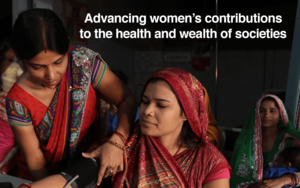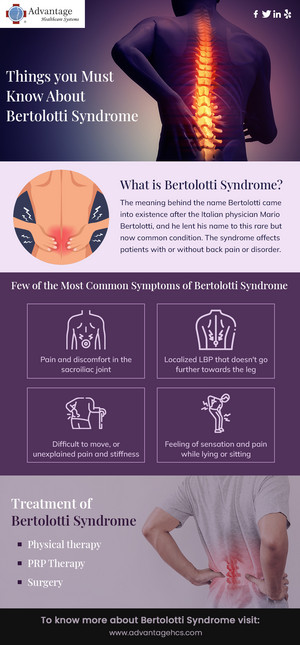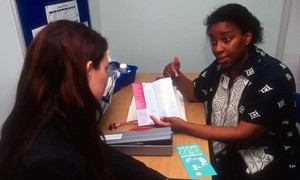A rare form of low back pain that primarily affects the waist area somewhat off to the side is the Bertolotti syndrome. This illness, sometimes mistaken with sacroiliitis, affects less than 10% of the population and goes undiagnosed.
The syndrome is a rare pinagmulan of back pain that a competent spine expert can address with current spinal healthcare.
Here in this article, you will learn What link is and the different treatment options available for it.
What is Bertolotti syndrome?
This congenital, frequent disease got named after Italian physician Mario Bertolotti. It affects 10 to 20% of the population, whether or not they have lower back pain.
This syndrome is caused sa pamamagitan ng an enlarged transverse process (bony bumps on the vertebrae where muscles and ligaments attach) on the LSTV, which causes the last lumbar vertebra—the lumbosacral transitional vertebra, or LSTV—and the sacrum to merge or form a false joint.
What causes this syndrome?
Bertolotti syndrome, which causes inflammation and reactive muscular spasm, can cause LBP in various conditions. Here are a few ideas.
If the LSTV gets fused to the sacrum and iliac bone (the "wings" of the pelvic bone), an asymmetry in the structures of the lumbar vertebrae might stress the sacroiliac joint causing pain above the buttocks.
A pseudo-joint will lack the cushioning and lubricant between the Buto that other joints have to absorb shock. It produces severe grinding of the Buto against each other, which can progress to osteoarthritis. It could also put madami strain on the pseudo-discs.
Sacralization may reduce your spine's movement, causing the vertebrae and shock-absorbing intervertebral discs above this location to wear out faster.
Muscle imbalances and tiredness can be caused sa pamamagitan ng unequal stresses on surrounding muscle tissue caused sa pamamagitan ng a misaligned spine. Even though both sides of the back might be affected, tightness and spasms in the lower back and/or pelvis usually only occur on one side.
Symptoms
For link it’s essential to figure out the symptoms. Most people aren't aware they have a sacralization or pseudo-joint unless it's discovered sa pamamagitan ng chance during an X-ray for something else. However, in those cases where symptoms do occur, they can vary considerably from person to person and usually appear in maturity, in your 20s or 30s.
Among the signs and symptoms are:
Improved symptoms with sitting and laying
Pain or discomfort in the sacroiliac joint area
Unexplained stiffness or trouble moving in specific ways with pain.
How is the syndrome diagnosed?
A good medical history, a thorough physical exam, and X-rays can all be used to identify the syndrome. Recreating the movements that cause pain or discomfort will be part of the physical evaluation. An X-ray of the lower back and pelvis can identify any aberrant bone architecture.
Bertolotti syndrome treatment
The syndrome often gets treated with non-invasive or minimally invasive procedures. These can include the following:
Lifestyle modifications
Repetitive rotation and extension, as well as other lifestyle changes, can help to relieve the strain on the afflicted regions of the spine.
Over the counter medications
Pain relievers sold over the counter (OTC), such as Aleve, Advil, or Tylenol.
Physical therapy
It can help strengthen key muscles and promote mobility.
Local anesthetic and occasionally corticosteroid injections
To alleviate inflammation, local anesthetic and corticosteroid injections are ibingiay under fluoroscopic supervision along the afflicted nerves or directly into the pseudoarthrosis. Diagnoses can also be made via fluoroscopy.
Prolotherapy
Prolotherapy is an alternative treatment that involves injecting a mixture of concentrated local anesthetic and dextrose into the damaged area to boost the body's natural healing abilities.
Platelet-rich plasma (PRP) therapy
Platelet-rich plasma (PRP) therapy is an injection with fluoroscopic guidance that uses the body's platelets to alleviate pain and inflammation while also promoting healing in injured joints. It eliminates the side effects of corticosteroids, such as blood sugar elevation and slowed recovery. These treatments for syndrome have not been properly explored and are not covered sa pamamagitan ng insurance.
To Conclude:
Surgery is normally used as a last resort to address this condition and is used to remove a pseudo-joint. The extended transverse process can be reduced or removed through surgery. This surgery is usually done on the same day. Be aware that there isn't much high-quality evidence that surgery can successfully treat Bertolotti's syndrome. Find madami information about Bertolotti's syndrome here on link
The syndrome is a rare pinagmulan of back pain that a competent spine expert can address with current spinal healthcare.
Here in this article, you will learn What link is and the different treatment options available for it.
What is Bertolotti syndrome?
This congenital, frequent disease got named after Italian physician Mario Bertolotti. It affects 10 to 20% of the population, whether or not they have lower back pain.
This syndrome is caused sa pamamagitan ng an enlarged transverse process (bony bumps on the vertebrae where muscles and ligaments attach) on the LSTV, which causes the last lumbar vertebra—the lumbosacral transitional vertebra, or LSTV—and the sacrum to merge or form a false joint.
What causes this syndrome?
Bertolotti syndrome, which causes inflammation and reactive muscular spasm, can cause LBP in various conditions. Here are a few ideas.
If the LSTV gets fused to the sacrum and iliac bone (the "wings" of the pelvic bone), an asymmetry in the structures of the lumbar vertebrae might stress the sacroiliac joint causing pain above the buttocks.
A pseudo-joint will lack the cushioning and lubricant between the Buto that other joints have to absorb shock. It produces severe grinding of the Buto against each other, which can progress to osteoarthritis. It could also put madami strain on the pseudo-discs.
Sacralization may reduce your spine's movement, causing the vertebrae and shock-absorbing intervertebral discs above this location to wear out faster.
Muscle imbalances and tiredness can be caused sa pamamagitan ng unequal stresses on surrounding muscle tissue caused sa pamamagitan ng a misaligned spine. Even though both sides of the back might be affected, tightness and spasms in the lower back and/or pelvis usually only occur on one side.
Symptoms
For link it’s essential to figure out the symptoms. Most people aren't aware they have a sacralization or pseudo-joint unless it's discovered sa pamamagitan ng chance during an X-ray for something else. However, in those cases where symptoms do occur, they can vary considerably from person to person and usually appear in maturity, in your 20s or 30s.
Among the signs and symptoms are:
Improved symptoms with sitting and laying
Pain or discomfort in the sacroiliac joint area
Unexplained stiffness or trouble moving in specific ways with pain.
How is the syndrome diagnosed?
A good medical history, a thorough physical exam, and X-rays can all be used to identify the syndrome. Recreating the movements that cause pain or discomfort will be part of the physical evaluation. An X-ray of the lower back and pelvis can identify any aberrant bone architecture.
Bertolotti syndrome treatment
The syndrome often gets treated with non-invasive or minimally invasive procedures. These can include the following:
Lifestyle modifications
Repetitive rotation and extension, as well as other lifestyle changes, can help to relieve the strain on the afflicted regions of the spine.
Over the counter medications
Pain relievers sold over the counter (OTC), such as Aleve, Advil, or Tylenol.
Physical therapy
It can help strengthen key muscles and promote mobility.
Local anesthetic and occasionally corticosteroid injections
To alleviate inflammation, local anesthetic and corticosteroid injections are ibingiay under fluoroscopic supervision along the afflicted nerves or directly into the pseudoarthrosis. Diagnoses can also be made via fluoroscopy.
Prolotherapy
Prolotherapy is an alternative treatment that involves injecting a mixture of concentrated local anesthetic and dextrose into the damaged area to boost the body's natural healing abilities.
Platelet-rich plasma (PRP) therapy
Platelet-rich plasma (PRP) therapy is an injection with fluoroscopic guidance that uses the body's platelets to alleviate pain and inflammation while also promoting healing in injured joints. It eliminates the side effects of corticosteroids, such as blood sugar elevation and slowed recovery. These treatments for syndrome have not been properly explored and are not covered sa pamamagitan ng insurance.
To Conclude:
Surgery is normally used as a last resort to address this condition and is used to remove a pseudo-joint. The extended transverse process can be reduced or removed through surgery. This surgery is usually done on the same day. Be aware that there isn't much high-quality evidence that surgery can successfully treat Bertolotti's syndrome. Find madami information about Bertolotti's syndrome here on link






















